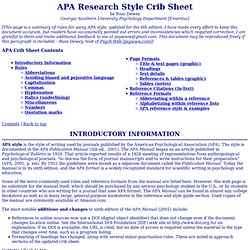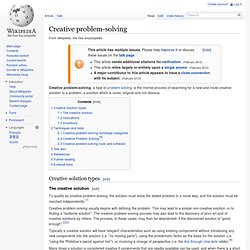

FreeBookSpot.cc. APA Research Style Crib Sheet. APA Research Style Crib Sheetby Russ DeweyGeorgia Southern University Psychology Department [Emeritus] [This page is a summary of rules for using APA style, updated for the 6th edition.

I have made every effort to keep this document accurate, but readers have occasionally pointed out errors and inconsistencies which required correction. I am grateful to them and invite additional feedback to me at psywww@gmail.com. This document may be reproduced freely if this paragraph is included. Animal Assisted Therapy for Special Needs Children. Want to help your child?

Call 866-777-0799 and find a program for your son or daughter today. Kids and animals are a natural combination. Pets are great companions, and they teach the value of responsibility to children. For children with disabilities, this companionship is particularly invaluable, as they may have trouble making friends with kids their own ages because of low self-esteem. Animals give children an opportunity to connect with another living being, which is extremely important to any child's development. Is Animal Assisted Therapy Really the Cat's Meow? IN 1857 British novelist George Eliot wrote, “Animals are such agreeable friends.

They ask no questions and they pass no criticism.” So it is no surprise that scholars have long been intrigued by the possibility that animals possess largely untapped therapeutic powers. But are animals good for our psychological and physical health, either as pets or as “therapists”? Most Americans are animal lovers; about 63 percent of U.S. households contain one or more pets, according to the American Pet Products Manufacturers Association. Potential Benefits of Animal Assisted Therapy. THE POTENTIAL BENEFITS of ANIMAL ASSISTED THERAPY FOR CHILDREN WITH SPECIAL NEEDS Dawn Oakley OTR/L and Gail Bardin, OTR/L According to journalist Odean Cusack, “Anyone who has ever owned a pet will readily verify the benefits of associating with furred, feathered, or finned friends.

Therapy Dogs International. “Tail Waggin’ Tutors” Children Reading to Dogs The main objective of this program is to provide a relaxed and “dog-friendly” atmosphere, which allows students to practice the skill of reading.

Many of the children chosen for this program have difficulties reading and as a result have developed self-esteem issues. They are often self-conscious when reading aloud in front of other classmates. By sitting down next to a dog and reading to the dog, all threats of being judged are put aside. As we have stated, improving the child’s skill of reading is the major benefit of the program. A Handler in the DVD points out that it “builds excitement about reading.” Creative problem solving. Creative problem-solving, a type of problem solving, is the mental process of searching for a new and novel creative solution to a problem, a solution which is novel, original and not obvious.

Creative solution types[edit] The creative solution[edit] To qualify as creative problem-solving, the solution must solve the stated problem in a novel way, and the solution must be reached independently.[1] Lateral thinking. Lateral thinking is solving problems through an indirect and creative approach, using reasoning that is not immediately obvious and involving ideas that may not be obtainable by using only traditional step-by-step logic.

The term was coined in 1967 by Edward de Bono. [1] According to de Bono, lateral thinking deliberately distances itself from standard perceptions of creativity as either "vertical" logic (the classic method for problem solving: working out the solution step-by-step from the given data) or "horizontal" imagination (having many ideas but being unconcerned with the detailed implementation of them). Methods[edit] Critical thinking is primarily concerned with judging the true value of statements and seeking errors. Lateral thinking is more concerned with the "movement value" of statements and ideas.
Random Entry Idea Generating Tool: The thinker chooses an object at random, or a noun from a dictionary, and associates it with the area they are thinking about. Collaboration Beats Smarts In Group Problem Solving. Feeling Words. Emotional Intelligence | Emotional Literacy Feeling Words / Emotion WordsWords Describing Feelings and Emotions * = Newly created words Thanks to all the people who have contributed new words.

I am sorry but it has proven impractical for me to name them all. A special thanks, though to Bob Myrick at the University of Florida. Ordering Details Click here to make a donation for the list. The requested donation amount is 5 US dollars for personal use. If you want to pay by check, please email at the above email address to see where in the world I am these days!
Thanks. Steve. Personality Disorders. Top 10 Psychology Studies of 2010. The end of 2010 fast approaches, and I'm thrilled to have been asked by the editors of Psychology Today to write about the Top 10 psychology studies of the year. I've focused on studies that I personally feel stand out, not only as examples of great science, but even more importantly, as examples of how the science of psychology can improve our lives. Each study has a clear "take home" message, offering the reader an insight or a simple strategy they can use to reach their goals , strengthen their relationships, make better decisions, or become happier. If you extract the wisdom from these ten studies and apply them in your own life, 2011 just might be a very good year. Defense Mechanism Examples. APA Style.